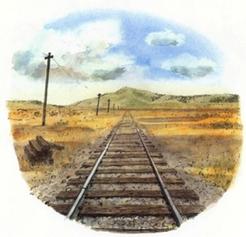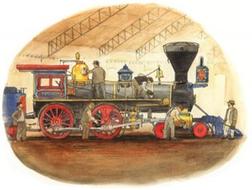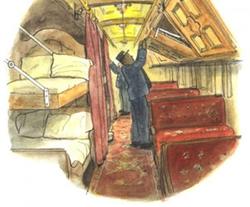 Brian Floca's impeccably researched and illustrated information books have long been honored for their accuracy (with three Robert F. Sibert Honor Awards given to "the most distinguished informational book). With Locomotive, he becomes "the artist of the most distinguished American picture book for children," as winner of the 2014 Caldecott Medal. This majestic picture book follows one family from Omaha, Neb., to Sacramento, Calif., as they travel the route of the Transcontinental Railroad. The book also received a 2014 Sibert Honor.
Brian Floca's impeccably researched and illustrated information books have long been honored for their accuracy (with three Robert F. Sibert Honor Awards given to "the most distinguished informational book). With Locomotive, he becomes "the artist of the most distinguished American picture book for children," as winner of the 2014 Caldecott Medal. This majestic picture book follows one family from Omaha, Neb., to Sacramento, Calif., as they travel the route of the Transcontinental Railroad. The book also received a 2014 Sibert Honor.
Congratulations!
Thank you so much!
Did you have a highball to celebrate? ["Highball" is an old railroad signal to indicate that the way is clear; that's where the drink comes from.]
Ha ha ha! Not yet!
Locomotive won a Caldecott Medal and a Sibert Honor. Is it especially gratifying to be recognized for both your artistry and your expertise and accuracy?
I was always trying to make a picture book, and also trying to relate the story of the Transcontinental Railroad, so to be recognized on both levels is very gratifying.
 Do you think that growing up in Texas fostered your appreciation for wide-open spaces? Your books inspire such emotional responses from readers--with the image of the plains out the train windows in Locomotive, Buzz Aldrin's view as he looks back at the earth in Moonshot, the landscape of the hills in western Pennsylvania as the wedding backdrop in Ballet for Martha.
Do you think that growing up in Texas fostered your appreciation for wide-open spaces? Your books inspire such emotional responses from readers--with the image of the plains out the train windows in Locomotive, Buzz Aldrin's view as he looks back at the earth in Moonshot, the landscape of the hills in western Pennsylvania as the wedding backdrop in Ballet for Martha.
I think it must have. Going from Texas to New England and then to New York--I don't want to get too much on the couch about it--but I do feel, when I'm back in Texas, the openness of it, and it's great.
You've talked about your passion for research, and how it's led the shaping of Locomotive's narrative in unexpected directions. Would you say that your research has also led your artwork in unexpected directions?
I've never thought of myself as a very technical person, but in trying to show these journeys, I like to make them possible, and trying to draw them has led me to try to understand how they work. I started Moonshot not even knowing whether I was going to try to get the craters on the moon right, or if anyone would even care. The more I researched, the more those elements became meaningful to me, and the more I wanted them in the book.
In the very early drafts of Locomotive, I had in mind that we wanted mountains, a tunnel and a bridge. I put those into the book in whatever order, and it became the landscape of the Transcontinental Railroad. Then it became a particular bridge and a particular tunnel and a particular range of mountains, then the most interesting bridge and the most interesting tunnel.
In one of your blog posts about Moonshot, you discuss "murdering your darlings," in this case, killing off an LP of Bob Dylan's Nashville Skyline (his spring 1969 release), and then admitting that you "miss[ed] Bob." Was there anything you had to take out of Locomotive that you miss?
Originally, I had a drawing of a robber baron that Dick [Jackson] and I liked a lot. But he didn't fit into the narrative. The book is about traveling on and operating the train. He was a type I had in my mind, and he didn't grow out of the people on the [Transcontinental Railroad] at the time. He got cut and I missed him a little, but that was for the best. [The lines appear here:]
And far away,
the man who owns the railroad,
who buys the land, who makes decisions.
Hard work, too, he would say!
(But he would not lift a hammer, no,
he would not shovel coal.)
Your first book for children--City of Light, City of Dark (1993)--was written by Avi, to whom Locomotive is dedicated. How did that project come to be?
That came to me because Avi had a novel he'd written, and at some point decided he wanted to publish it not as a novel but as a graphic novel. He just wrote a blog post about it. Avi got in touch with David Macaulay, who was teaching at RISD [the Rhode Island School of Design], and Macaulay introduced me to Avi. I did some sample chapters, and Avi sold the book to Dick [Jackson].
 Did you always think you would be an artist?
Did you always think you would be an artist?
I think I always wanted to be, but I don't think I knew what kind of artist I wanted to be. I always knew I loved drawing, but I didn't know what I'd be able to do with it.
Why do you prefer to work in watercolors?
I've always felt like more of a drawer than a painter. With watercolors, I get to start with pen-and-inks; that appeals to me. I love the human quality of them, how visible the media is. I love that you can see some of the mistakes the artist has made--hopefully not too many.
Tell us how you came to children's books.
It was really through that project [City of Light, City of Dark]. In [college], I was doing a lot of cartooning, and I was interested in words and pictures. David Macaulay taught a class at RISD, and I took it, and that led to meeting Avi, and I did that first book with Dick, and then got a manuscript from Dick, and then I started sending stories to him.
 What was the first book you both wrote and illustrated?
What was the first book you both wrote and illustrated?
It was called The Frightful Story of Harry Walfish. You see why it's gone out of print. Too many words.
Dick Jackson edited what we like to call your triptych--Lightship, Moonshot and Locomotive. What has it been like to collaborate with him?
There's not enough wonderful things to say about Dick Jackson. There's intelligence, humor, his sense of what works in a book, and the level of trust and knowing each other we've developed over 20 years. I'm not afraid to take something to him, whether I think it's working or not. We think a lot of each other and each other's work and that's a huge part of the process, I think. --Jennifer M. Brown

